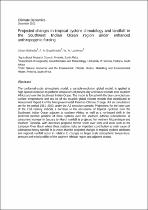 ResearchSpace
ResearchSpace
Projected changes in tropical cyclone climatology and landfall in the Southwest Indian Ocean region under enhanced anthropogenic forcing
JavaScript is disabled for your browser. Some features of this site may not work without it.
- ResearchSpace
- →
- Research Publications/Outputs
- →
- Journal Articles
- →
- View Item
| dc.contributor.author |
Malherbe, Johan

|
|
| dc.contributor.author |
Engelbrecht, FA

|
|
| dc.contributor.author |
Landman, WA

|
|
| dc.date.accessioned | 2013-04-11T10:29:44Z | |
| dc.date.available | 2013-04-11T10:29:44Z | |
| dc.date.issued | 2012-12 | |
| dc.identifier.citation | Malherbe, J, Engelbrecht, F.A and Landman, W.A. 2012. Projected changes in tropical cyclone climatology and landfall in the Southwest Indian Ocean region under enhanced anthropogenic forcing. Climate Dynamics, pp 1-20 | en_US |
| dc.identifier.issn | 0930-7575 | |
| dc.identifier.uri | http://link.springer.com/article/10.1007/s00382-012-1635-2?null# | |
| dc.identifier.uri | http://hdl.handle.net/10204/6658 | |
| dc.description | Copyright: 2012 Springer-Verlag Berlin Heidelberg. This is an ABSTRACT ONLY. The definitive version is published in Climate Dynamics DOI 10.1007/s00382-012-1635-2 | en_US |
| dc.description.abstract | The conformal-cubic atmospheric model, a variable-resolution global model, is applied at high spatial resolution to perform simulations of present-day and future climate over southern Africa and over the Southwest Indian Ocean. The model is forced with the bias-corrected sea-surface temperatures and sea-ice of six coupled global climate models that contributed to Assessment Report 4 of the Intergovernmental Panel on Climate Change. All six simulations are for the period 1961–2100, under the A2 emission scenario. Projections for the latter part of the 21st century indicate a decrease in the occurrence of tropical cyclones over the Southwest Indian Ocean adjacent to southern Africa, as well as a northward shift in the preferred landfall position of these systems over the southern African subcontinent. A concurrent increase in January to March rainfall is projected for northern Mozambique and southern Tanzania, with decreases projected further south over semi-arid areas such as the Limpopo River Basin where these systems make an important contribution as main cause of widespread heavy rainfall. It is shown that the projected changes in tropical cyclone attributes and regional rainfall occur in relation to changes in larger scale atmospheric temperature, pressure and wind profiles of the southern African region and adjacent oceans. | en_US |
| dc.language.iso | en | en_US |
| dc.publisher | Springer | en_US |
| dc.relation.ispartofseries | Workflow;10103 | |
| dc.subject | Tropical cyclones | en_US |
| dc.subject | Atmospheric models | en_US |
| dc.subject | Climate change | en_US |
| dc.subject | Southwest Indian Ocean | en_US |
| dc.title | Projected changes in tropical cyclone climatology and landfall in the Southwest Indian Ocean region under enhanced anthropogenic forcing | en_US |
| dc.type | Article | en_US |
| dc.identifier.apacitation | Malherbe, J., Engelbrecht, F., & Landman, W. (2012). Projected changes in tropical cyclone climatology and landfall in the Southwest Indian Ocean region under enhanced anthropogenic forcing. http://hdl.handle.net/10204/6658 | en_ZA |
| dc.identifier.chicagocitation | Malherbe, Johan, FA Engelbrecht, and WA Landman "Projected changes in tropical cyclone climatology and landfall in the Southwest Indian Ocean region under enhanced anthropogenic forcing." (2012) http://hdl.handle.net/10204/6658 | en_ZA |
| dc.identifier.vancouvercitation | Malherbe J, Engelbrecht F, Landman W. Projected changes in tropical cyclone climatology and landfall in the Southwest Indian Ocean region under enhanced anthropogenic forcing. 2012; http://hdl.handle.net/10204/6658. | en_ZA |
| dc.identifier.ris | TY - Article AU - Malherbe, Johan AU - Engelbrecht, FA AU - Landman, WA AB - The conformal-cubic atmospheric model, a variable-resolution global model, is applied at high spatial resolution to perform simulations of present-day and future climate over southern Africa and over the Southwest Indian Ocean. The model is forced with the bias-corrected sea-surface temperatures and sea-ice of six coupled global climate models that contributed to Assessment Report 4 of the Intergovernmental Panel on Climate Change. All six simulations are for the period 1961–2100, under the A2 emission scenario. Projections for the latter part of the 21st century indicate a decrease in the occurrence of tropical cyclones over the Southwest Indian Ocean adjacent to southern Africa, as well as a northward shift in the preferred landfall position of these systems over the southern African subcontinent. A concurrent increase in January to March rainfall is projected for northern Mozambique and southern Tanzania, with decreases projected further south over semi-arid areas such as the Limpopo River Basin where these systems make an important contribution as main cause of widespread heavy rainfall. It is shown that the projected changes in tropical cyclone attributes and regional rainfall occur in relation to changes in larger scale atmospheric temperature, pressure and wind profiles of the southern African region and adjacent oceans. DA - 2012-12 DB - ResearchSpace DP - CSIR KW - Tropical cyclones KW - Atmospheric models KW - Climate change KW - Southwest Indian Ocean LK - https://researchspace.csir.co.za PY - 2012 SM - 0930-7575 T1 - Projected changes in tropical cyclone climatology and landfall in the Southwest Indian Ocean region under enhanced anthropogenic forcing TI - Projected changes in tropical cyclone climatology and landfall in the Southwest Indian Ocean region under enhanced anthropogenic forcing UR - http://hdl.handle.net/10204/6658 ER - | en_ZA |





